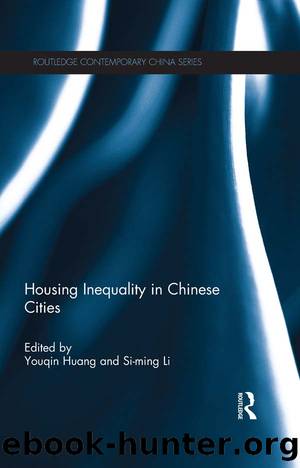Housing Inequality in Chinese Cities by Youqin Huang Si-ming Li

Author:Youqin Huang, Si-ming Li [Youqin Huang, Si-ming Li]
Language: eng
Format: epub
ISBN: 9780415834285
Barnesnoble:
Publisher: Taylor & Francis
Published: 2014-02-26T00:00:00+00:00
Figure 7.2 Number of verified applicants for Cheap Rental Housing in Beijing.
An empirical analysis
The following empirical study utilizes mainly the CRH Application Verification Information System dataset, which is complied by Beijing Housing Indemnity Office (BHIO). It includes the profiles of applicants for CRH who have passed the verification system â verified applicants. Qualitative data such as reports by BHIO, and interviews of BHIO staff and CRH applicants are also used.
The number of verified CRH applicants was very small in the first a few years of the twenty-first century (only 156 in 2001 and 821 in 2005) (Figure 7.2). But it has been increasing rapidly especially since 2007 when the government refo-cused on low-income housing, and established the ambitious goal of âying bao jin baoâ (BMG, 2007b, c). The number of verified applicants reached 6,893 in 2008 and 7,336 in 2009. By March of 2010, the cumulative number of verified applicants for CRH in Beijing reached 22,788 households.
Verified applicants for CRH come mostly from the urban core, with about 49 per cent from the old urban districts, 38 per cent from the new urban districts, and only 13 per cent from the far suburbs (Table 7.2).5 The main reason for the urban concentration of CRH applicants is that urban households with per capita living space less than 10 m2 and the lowest-income urban households mostly live in the inner city due to the prevalence of old dilapidated bungalows in the inner city. Most of CRH applicants are in their 40s and over 50, and the most common household structure is three-person households due to the one-child policy. Not surprisingly, âdi baoâ households account for more than 60 per cent of CRH applicants. It is clear that households with low income and assets are given priority to pass the verification. More than 60 per cent of verified applicants have annual household income less than 5,000 yuan, and 98 per cent have less than 20,000 yuan, while 82 per cent of applicants have no assets at all.
Table 7.2 Characteristics of verified applicants for Cheap Rental Housing N % %
Total 22788 100 Age
Old urban districts 11146 48.9 < = 30 5.8
Xicheng 6063 26.6 31â40 15.9
Dongcheng 5083 22.3 41â50 48.8
New urban districts 8707 38.2 51â60 21.2
Chaoyang 2787 12.2 61 + 8.3
Fengtai 2266 9.9
Shijingshan 2247 9.9 Household type
Haidian 1407 6.2 Missing 0.1
Far suburbs 2935 13.0 Di bao households 62.8
Fangshan 320 1.4 Low-income households 35.1
Tongzhou 743 3.3 Other special groups 2.0
Shunyi 84 0.4
Changping 165 0.7 Household size
Daxing 76 0.3 3-person 38.8
Mentougou 929 4.1
Huairou 136 0.6 Annual household income (1,000 yuan)
Pinggu 18 0.1 0 48.6
Miyun 309 1.4 0 <X< = 5 11.5
Yanqing 155 0.7 5 <X < = 10 14.6
10<X < = 15 14.1
15<X < = 20 8.8
20 + 2.4
Household assets (1,000 yuan) 82.3
0 <X < = 50 11
50 <X < = 100 3.2
100 <X < = 150 2.0
150 + 1.5
Download
This site does not store any files on its server. We only index and link to content provided by other sites. Please contact the content providers to delete copyright contents if any and email us, we'll remove relevant links or contents immediately.
| Civil Rights | Discrimination |
| General | Human Rights |
Day by Elie Wiesel(2252)
The Age of Genius by A. C. Grayling(2177)
Gideon's Spies: The Secret History of the Mossad by Gordon Thomas(1956)
The Gulag Archipelago (Vintage Classics) by Aleksandr Solzhenitsyn(1732)
FATWA: Hunted in America by Pamela Geller(1726)
Columbine by Dave Cullen(1505)
Examples & Explanations: Administrative Law by William F. Funk & Richard H. Seamon(1334)
Men Explain Things to Me by Rebecca Solnit(1324)
The Rule of Law by Bingham Tom(1323)
Anatomy of Injustice by Raymond Bonner(1273)
Three Cups of Tea by Greg Mortenson(1264)
ADHD on Trial by Michael Gordon(1247)
That Every Man Be Armed by Stephen P. Halbrook(1244)
Gideon's Spies by Gordon Thomas(1219)
Palestinian Walks by Raja Shehadeh(1145)
The Source by James A. Michener(1140)
Fast Times in Palestine by Pamela Olson(1123)
Nothing to Envy by Barbara Demick(1045)
Constitutional Theory by Carl Schmitt(1042)
